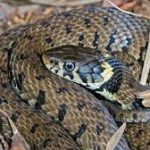Grass Snake

The Grass Snake
Natrix natrix
Not many of us are lucky to have come across one of the beautiful , shy , non venomous Grass Snakes, especially these days
But I had one as a child, rescued by my father who found it in distress, surrounded by strangers. The Grass Snake was feigning ‘dead’. its only defence against predators, apart from giving off a very nasty smell. I loved that snake, so beautiful and fascinating.
Many decades later, while out salmon fishing on the Wye, after a spate in early Autumn, I was transfixed by what looked like a floating leaf, cutting straight across the current. I stopped fishing as I couldn’t make out what I was seeing, until it slithered onto the bank and vanished at speed. It was a Grass Snake, swimming, seemingly effortlessly across the mighty Wye, while in full spate. I will never forget that sight
At this time of year, these, now rare Snakes are preparing for hibernation and need to fatten up as much as they can, like so many other hibernators such as hedgehogs, dormice, frogs, toads, newts, lizards, bees and butterflies etc. Our Grass Snake will seek out somewhere warm like a compost pile or a rabbit hole where it can hibernate for the Winter.
Their natural environment, such as wetlands, is in decline as well as their food source, such as frogs and toads. You will be remarkably lucky to see one as they will usually disappear rather than confront you
They are our largest snake, measuring up to metre in length, with a beautiful olive green body with yellow markings around the head, and they are totally non venomous. It is well worth learning the difference between the Grass Snake and the Adder. Our Grass Snake is the only egg-lying snake we have and its eggs hatch in August to September. The little baby snakes are no bigger than a pencil, and they must somehow survive through the first Winter
Nature is awesome and we should show it our respect
Athene English